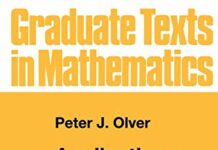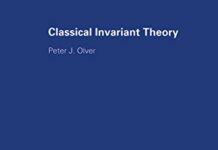
Ebook Info
- Published: 2018
- Number of pages: 704 pages
- Format: PDF
- File Size: 8.76 MB
- Authors: Peter J. Olver
Description
This textbook develops the essential tools of linear algebra, with the goal of imparting technique alongside contextual understanding. Applications go hand-in-hand with theory, each reinforcing and explaining the other. This approach encourages students to develop not only the technical proficiency needed to go on to further study, but an appreciation for when, why, and how the tools of linear algebra can be used across modern applied mathematics.Providing an extensive treatment of essential topics such as Gaussian elimination, inner products and norms, and eigenvalues and singular values, this text can be used for an in-depth first course, or an application-driven second course in linear algebra. In this second edition, applications have been updated and expanded to include numerical methods, dynamical systems, data analysis, and signal processing, while the pedagogical flow of the core material has been improved. Throughout, the text emphasizes the conceptual connections between each application and the underlying linear algebraic techniques, thereby enabling students not only to learn how to apply the mathematical tools in routine contexts, but also to understand what is required to adapt to unusual or emerging problems.No previous knowledge of linear algebra is needed to approach this text, with single-variable calculus as the only formal prerequisite. However, the reader will need to draw upon some mathematical maturity to engage in the increasing abstraction inherent to the subject. Once equipped with the main tools and concepts from this book, students will be prepared for further study in differential equations, numerical analysis, data science and statistics, and a broad range of applications. The first author’s text, Introduction to Partial Differential Equations, is an ideal companion volume, forming a natural extension of the linear mathematical methods developed here.
User’s Reviews
Editorial Reviews: From the Back Cover This textbook develops the essential tools of linear algebra, with the goal of imparting technique alongside contextual understanding. Applications go hand-in-hand with theory, each reinforcing and explaining the other. This approach encourages students to develop not only the technical proficiency needed to go on to further study, but an appreciation for when, why, and how the tools of linear algebra can be used across modern applied mathematics.Providing an extensive treatment of essential topics such as Gaussian elimination, inner products and norms, and eigenvalues and singular values, this text can be used for an in-depth first course, or an application-driven second course in linear algebra. In this second edition, applications have been updated and expanded to include numerical methods, dynamical systems, data analysis, and signal processing, while the pedagogical flow of the core material has been improved. Throughout, the text emphasizes the conceptual connections between each application and the underlying linear algebraic techniques, thereby enabling students not only to learn how to apply the mathematical tools in routine contexts, but also to understand what is required to adapt to unusual or emerging problems.No previous knowledge of linear algebra is needed to approach this text, with single-variable calculus as the only formal prerequisite. However, the reader will need to draw upon some mathematical maturity to engage in the increasing abstraction inherent to the subject. Once equipped with the main tools and concepts from this book, students will be prepared for further study in differential equations, numerical analysis, data science and statistics, and a broad range of applications. The first author’s text, Introduction to Partial Differential Equations, is an ideal companion volume, forming a natural extension of the linear mathematical methods developed here. About the Author Peter Olver is Professor of Mathematics at University of Minnesota, Twin Cities. His research centers around Lie groups, differential equations, and various areas of applied mathematics. His previous books include Introduction to Partial Differential Equations (Springer, UTM, 2014), and Applications of Lie Groups to Differential Equations (Springer, GTM 107, 1993).Chehrzad Shakiban is Professor of Mathematics at University of St. Thomas, St. Paul. Her interests include calculus of variations, computer vision, and innovative learning experiences that illustrate connections between mathematics and the arts.
Reviews from Amazon users which were colected at the time this book was published on the website:
⭐A detailed look at Linear algebra from your first semester all the way through graduate work on the subject. My only criticism is that it has less application in the world of physics and other disciplines than hoped for.
⭐It doesn’t have much note or mark on it, neat
⭐I don’t like this textbook because it doesn’t give a lot of examples to help you learn the subject. Bought it because I had too.
⭐I used this book for an Undergraduate Applied Linear Algebra course. I found it very easy to read, and the notation to be very well done and sensible. The majority of the end of chapter exercises tend to involve theory more than application. I found a lot of the exercises difficult at first, but in the end very rewarding. Like another review stated, I would not recommend this text as an introductory text, but rather one for a second course in Linear Algebra. I did not find that the text assumes much of the reader, but being trained in other domains of mathematics is helpful to understand the book. I’m confident that a self motivated self learner could utilize this book, but would ultimately benefit most from a concurrent course.
⭐Its a dense but OK text book. The book is not very friendly from an applied mathematics standpoint, but geared towards theoretical side, but it is still reasonable to use this for an applied course. I have some great graduate level books that are easier to follow along (theoretical and applied). The book should only be used as your second or third linear algebra course, and not something to e picked up if this is your first LA course. The notation is also very goofy and no effort was made to make it easier for the reader. For e.g (v, w E V, and obviously we have W belongs to V ) – why use a lower case v and w here? why not just pick something else? This is much easier to read e.g. (s, t E V) . Few more goofy things include matrix transpose representations..sometimes its (3,0,1)^T…sometimes just as a column vector – (not to save space or anything). If you are taking a graduate level course I would recommend this textbookhttps://www.amazon.com/Linear-Algebra-Graduate-Studies-Mathematics/dp/082183813X/ref=sr_1_3?keywords=linear+algebra+in+action&qid=1563203049&s=gateway&sr=8-3
⭐It is a high-quality printing book with a relatively low price.A lot of topics are discussed. It is friendly to read for engineers.
⭐Purchased for a second-year linear algebra course. Textbook is clear and concise but could use more examples. The book itself arrived in good condition and is of higher-quality paper than expected.
Keywords
Free Download Applied Linear Algebra (Undergraduate Texts in Mathematics) in PDF format
Applied Linear Algebra (Undergraduate Texts in Mathematics) PDF Free Download
Download Applied Linear Algebra (Undergraduate Texts in Mathematics) 2018 PDF Free
Applied Linear Algebra (Undergraduate Texts in Mathematics) 2018 PDF Free Download
Download Applied Linear Algebra (Undergraduate Texts in Mathematics) PDF
Free Download Ebook Applied Linear Algebra (Undergraduate Texts in Mathematics)




